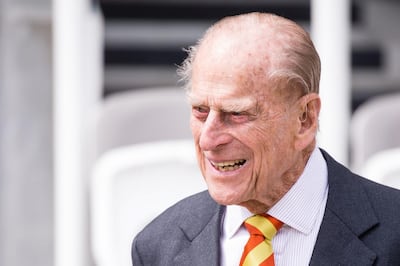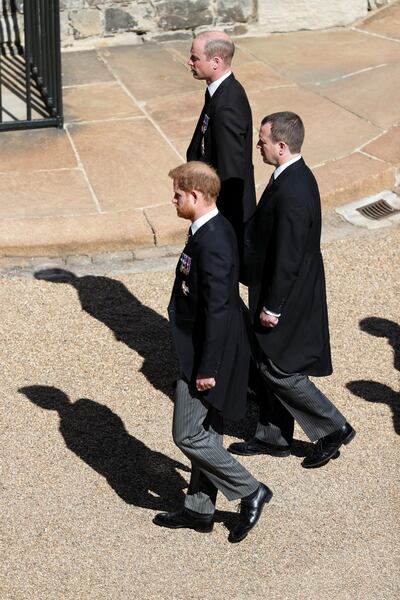Queen Elizabeth and her family paid their last respects to Prince Philip at a funeral on Saturday that celebrated his naval past, his international heritage and seven decades of service in which he helped guide the Queen through repeated crises.
Dressed in black and in a white-trimmed black mask, the Queen stood alone as the body of her husband of 73 years was lowered into the Royal Vault.
The service was attended by senior royals including Prince Charles and his sons, Princes William and Harry.
Owing to social distancing rules, the Queen sat alone during the ceremony at St George’s Chapel.
“We remember before thee this day Philip, Duke of Edinburgh, rendering thanks unto thee – for his resolute faith and loyalty, for his high sense of duty and integrity,” Archbishop of Canterbury Justin Welby said in a prayer.
The archbishop praised Prince Philip’s “life of service to the nation and Commonwealth, and for the courage and inspiration of his leadership”.
Prince Philip died at Windsor Castle aged 99 after a month of hospital treatment for a heart condition and an infection.
The Queen led the royal procession for his funeral at Windsor Castle, near London, on Saturday, followed by their children and grandchildren.
Music from military bands signalled the start of the proceedings, which were watched by millions.
Military officers lowered their heads in the grounds of the castle in west London as Jerusalem was played.
The coffin was placed on a green Land Rover which was followed by the Queen.
The funeral service was conducted by the Dean of Windsor, David Conner. He paid tribute to Price Philip’s “kindness, humour and humanity”.
The Queen wishes to share this private photograph taken with The Duke of Edinburgh at the top of the Coyles of Muick, Scotland in 2003.
— The Royal Family (@RoyalFamily) April 16, 2021
📷Photograph by The Countess of Wessex. pic.twitter.com/CE030Ux0UB
“We have been inspired by his unwavering loyalty to our Queen, by his service to the nation and the Commonwealth, by his courage, fortitude and faith,” the Dean of Windsor said.
More than 730 members of the armed forces took part in the event at Windsor Castle. They included army bands, Royal Marine buglers and an honour guard drawn from across the armed forces.
Armed forces bands played hymns and classical music and during the ceremony a small choir of four performed pieces of music chosen by Prince Philip.
Coronavirus restrictions meant that instead of the 800 mourners included in the longstanding plans for his funeral, there were only 30 people inside the castle’s St George’s Chapel, including the queen, her four children and her eight grandchildren.
The service commenced after a national minute’s silence was held at 3pm.
"The Royal Family just kept to the rules and that means they've gone through what millions of others have gone through which is not really being able to say goodbye in the way they'd hoped or planned," the Archbishop of Canterbury, Justin Welby, told The Telegraph.
“We can never fail to be admiring of the way Her Majesty behaved.”
Prince Philip’s body had been resting in the private chapel at Windsor Castle.
On Saturday, his coffin, covered with a wreath, his sword, naval cap and his personal standard, was moved by a bearer party from the Queen's Company, 1st Battalion Grenadier Guards to the royal residence's inner hall and later placed on the Land Rover as God Save the Queen was played.
Roses and lilies, which had been chosen by the Queen, were placed on top of it.
He spent almost 14 years in the Royal Navy and saw action in the Mediterranean, Indian Ocean and Pacific during the Second World War.
Several elements of his funeral had a maritime theme, including the hymn Eternal Father, Strong to Save, which is associated with seafarers.
The entire procession and funeral took place out of public view within the grounds of the castle, a 950-year-old royal residence 30 kilometres west of London, but was shown live on television.
Despite the public being asked not to attend, mourners gathered at the barriers erected along the sweeping Long Walk to the castle gates as armed police patrolled the area.
“There are hundreds of us today,” one mourner said.
“People are not supposed to come. But this is a once-in-a-generation event. He was really something.”
Flowers placed outside Windsor Castle were moved inside the grounds on Saturday so the family could view the tributes.
Britain’s longest-serving royal consort was an almost constant presence at the Queen’s side during her record-breaking reign, which began in 1952.
A montage to commemorate the extraordinary life of The Duke of Edinburgh, made unique by its sheer breadth of experience, and the wartime generation he was part of.
— The Royal Family (@RoyalFamily) April 17, 2021
With words by the Poet Laureate,
The Patriarchs - An Elegy. pic.twitter.com/rUr1cNi8lS
His death, after 73 years of marriage, has left a “huge void” in her life, the couple’s son, Prince Andrew said, and the family has described him as “the grandfather of the nation”.
Prince Philip’s biographer Gyles Brandreth had known him for 40 years.
“It was a great privilege to know him over so many years and remarkable to be given special access and help in writing his life story,” he said.
“It is an extraordinary story and unexpected in so many ways. He saw an early draft of my book and made some factual corrections, as well as a few caustic comments. He did not see the final version, but I hope it does him justice. I have not held anything back.”
In an interview with The Times, Mr Brandreth said: "With the Queen he was so supportive of her, he never, ever stepped in front of her, his instinct was impeccable, occasionally they would catch each other's eye and smile."
The Queen led the mourners as they paid their respects to the man she once called her “strength and stay”, and whose death closes a remarkable chapter for Britain’s most famous family.
The congregation was mostly close family members, including the couple’s four children: heir to the throne Prince Charles, 72, Princess Anne, 70, Prince Andrew, 61, and Prince Edward, 57.
Also present was Charles’ eldest son William, 38, who was joined by younger brother, Harry, 36, after he flew back last weekend from the US, where he now lives.
All eyes were on the brothers, whose mother was Charles’ first wife Princess Diana, after a reported falling out over Harry’s move to California with his American wife, Meghan, and their stinging criticisms of the royals during a televised interview.
Meghan, heavily pregnant with her second child, was advised not to travel on medical grounds. Harry has had to quarantine since arriving from Los Angeles.
The brothers, who as young boys walked behind their mother’s coffin at her funeral in 1997, followed the procession on foot, but not side by side.
Between them was their cousin, Princess Anne’s son Peter Phillips, 43.
During the procession, they continued to look straight ahead but after the service Prince Harry could be seen chatting with Prince William and his wife.
Funerals of senior royals are normally grand public affairs, honed over years of planning, combining pomp, pageantry, and a guest list that is a who’s who of world dignitaries.
The last major royal funeral, of the Queen’s mother in 2002, cost more than £5.4 million ($7.4 million).
Saturday’s ceremony has been be a more modest affair.
All guests, in mourning black, were required to wear black face masks before, during and after the ceremony.
While the request from Buckingham Palace and the government for the public to stay away from the funeral was largely obeyed, some could not resist.
"It's really a shame that because of the pandemic we can't pay a wider tribute to the exceptional man he was," said Ieuan Jones, who travelled to Windsor from Cardiff to honour the prince.
"He means even more now since he has died. To be perfectly honest I didn't realise the extent to what his life had been, what he had done for us all. He was a marvellous husband, wasn't he, to the Queen and the children. Just remarkable and I don't think we will see the like again," said Viv Davies, 70, from Worcestershire.
Prince Philip has been interred in the Royal Vault of St George’s Chapel.
As his coffin was lowered into the vault, Royal Marine buglers sounded Action Stations, an alarm that alerts sailors to prepare for battle, at his request.
When the Queen dies, he will be transferred to lie alongside her in the King George VI memorial chapel, where her father, George VI, her mother, and her younger sister, Princess Margaret, are interred.











